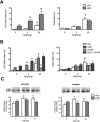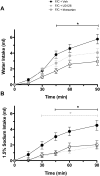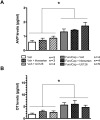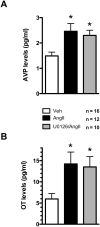Endogenous angiotensin II-induced p44/42 mitogen-activated protein kinase activation mediates sodium appetite but not thirst or neurohypophysial secretion in male rats
- PMID: 22913624
- PMCID: PMC4084568
- DOI: 10.1111/j.1365-2826.2012.02376.x
Endogenous angiotensin II-induced p44/42 mitogen-activated protein kinase activation mediates sodium appetite but not thirst or neurohypophysial secretion in male rats
Abstract
The renin-angiotensin-aldosterone system makes a critical contribution to body fluid homeostasis, and abnormalities in this endocrine system have been implicated in certain forms of hypertension. The peptide hormone angiotensin II (AngII) regulates hydromineral homeostasis and blood pressure by acting on both peripheral and brain targets. In the brain, AngII binds to the angiotensin type 1 receptor (AT1R) to stimulate thirst, sodium appetite and both arginine vasopressin (AVP) and oxytocin (OT) secretion. The present study used an experimental model of endogenous AngII to examine the role of p44/42 mitogen-activated protein kinase (MAPK) as a signalling mechanism to mediate these responses. Animals were given a combined treatment of furosemide and a low dose of captopril (furo/cap), comprising a diuretic and an angiotensin-converting enzyme inhibitor, respectively, to elevate endogenous AngII levels in the brain. Furo/cap induced p44/42 MAPK activation in key brain areas that express AT1R, and this effect was reduced with either a centrally administered AT1R antagonist (irbesartan) or a p44/42 MAPK inhibitor (U0126). Additionally, furo/cap treatment elicited water and sodium intake, and irbesartan markedly reduced both of these behaviours. Central injection of U0126 markedly attenuated furo/cap-induced sodium intake but not water intake. Furthermore, p44/42 MAPK signalling was not necessary for either furo/cap- or exogenous AngII-induced AVP or OT release. Taken together, these results indicate that p44/42 MAPK is required for AngII-induced sodium appetite but not thirst or neurohypophysial secretion. This result may allow for the discovery of more specific downstream targets of p44/42 MAPK to curb sodium appetite, known to exacerbate hypertension, at the same time as leaving thirst and neurohypophysial hormone secretion undisturbed.
© 2012 British Society for Neuroendocrinology.
Figures






References
-
- Peach MJ. Renin-angiotensin system: Biochemistry and mechanisms of action. Physiol Rev. 1977 Apr;57(2):313–70. - PubMed
-
- Bakris G. Are there effects of renin-angiotensin system antagonists beyond blood pressure control? American Journal of Cardiology. 2010;105:21A. - PubMed
-
- Ferguson AV, Washburn DL, Latchford KJ. Hormonal and neurotransmitter roles for angiotensin in the regulation of central autonomic function. Exp Biol Med (Maywood) 2001 Feb;226(2):85–96. - PubMed
-
- Geerling JC, Loewy AD. Central regulation of sodium appetite. Exp Physiol. 2008 Feb;93(2):177–209. - PubMed
Publication types
MeSH terms
Substances
Grants and funding
LinkOut - more resources
Full Text Sources
Other Literature Sources
Medical
Miscellaneous

